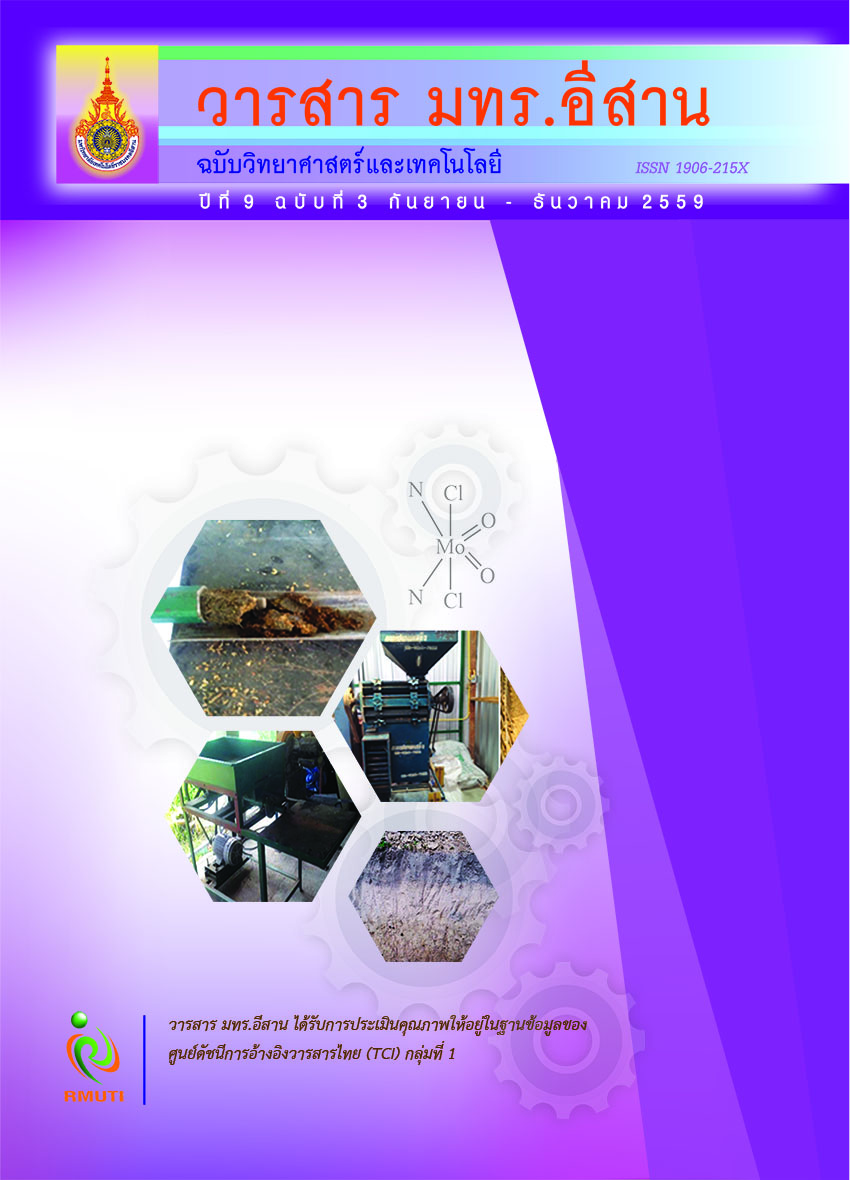การเพิ่มประสิทธิภาพการทำความเย็นของท่อใต้ดินโดยวิธีเพิ่มความชื้นดิน เพื่อใช้ในโรงเรือนเกษตร Enhancement of the Cooling Performance of Earth Tube System by Increasing Soil Moisture for Use in Agricultural Greenhouse
Main Article Content
Abstract
บทคัดย่อ
งานวิจัยนี้ได้ศึกษาความเป็นไปได้ของการเพิ่มประสิทธิภาพการทำความเย็นโดยใช้ท่อใต้ดินเพื่อการประยุกต์ใชใ้ นโรงเรือนเกษตรโดยวิธีเพิ่มความชื้นดิน ภายใตส้ ภาวะอากาศรอ้ นชื้นในฤดูฝนทางภาคเหนือของประเทศไทย ทอ่ ใตดิ้นที่ศึกษาเป็นท่อใต้ดินแบบตัวยู (U-Tube Heat Exchanger) ทำจากทอ่ พลาสติกโพลีไวนิลคลอไรด์ (PVC) เส้นผ่านศูนย์กลาง 0.08 m ความยาว 12.5 m ฝังใต้ดินความลึก 1 m ทดสอบ ณ วิทยาลัยพลังงานทดแทน มหาวิทยาลัยแม่โจ้ เชียงใหม่ จากการศึกษาพบว่า ท่อใต้ดินแบบตัวยูสามารถลดอุณหภูมิอากาศและทำความเย็นได้เฉพาะช่วงเวลากลางวันที่มีอุณหภูมิอากาศที่ไหลเข้าท่อค่อนข้างสูงโดยทอ่ ใตดิ้นที่ทดสอบสามารถทำงานไดต้ ั้งแตเ่ วลา 09.00 - 15.00 น. ทั้งนี้ความสามารถในการลดอุณหภูมิของท่อใต้ดินจะขึ้นอยู่กับอุณหภูมิแวดล้อม ซึ่งได้รับผลจากค่ารังสีอาทิตย์ สำหรับการวิเคราะห์หาค่ามุมการเปิดวาล์วที่เหมาะสม พบว่าค่ามุมวาล์วน้อยจะสามารถลดอุณหภูมิได้ดีกว่าค่ามุมที่กว้างกว่า และการเปิด มุมวาลว์ ที่ 45o จะสามารถลดอุณหภูมิของอากาศที่ไหลผ่านท่อได้มากที่สุด จากนั้นจึงทำการทดสอบสมรรถนะการทำความเย็นที่เงื่อนไขความชื้นดินต่างๆ กันพบว่าหากความชื้นดินมากจะสามารถลดอุณหภูมิดิน
ได้ไม่เกิน 1oC และมีผลตอ่ การเพิ่มสัมประสิทธ์ิสมรรถนะการทำความเย็นหรือค่า COP น้อยเมื่อเปรียบเทียบผลที่เกิดจากการเพิ่มผลต่างอุณหภูมิอากาศที่ไหลเข้าท่อกับอุณหภูมิดิน ดังนั้นกรณีดินที่มีความชื้นน้อยจะให้สมรรถนะการทำความเย็นของระบบมากกว่าดินที่มีความชื้นมาก
Abstract
This research studied the cooling possibility of earth tube system (ETS) by increasingsoil moisture for agricultural greenhouse. The study was under taken during the raining season of northern Thailand. The type of ETS was the U-Tube heat exchanger made from polyvinyl chroride (PVC). The tube diameter and length were 0.08 m and 12.5 m, respectively embedded horizontally at a depth of 1 m at the School of Renewable Energy, Maejo University, Chiang Mai. The results showed that the air temperature would be cooled only during daytime when inlet air temperature was relatively high. The U-Tube heat exchanger could operate in cooling mode from 9 a.m. to 3 p.m. The ability of air temperature reducing depended on the ambient temperature which was affected by solar radiation. The valve opening for airflow control into the U-Tube heat exchanger showed that the narrow angles could reduce air temperature better than the wide angle. The suitable angle of valve opening was 45o, at which the blower temperature increased in the acceptable range. For the performance study of various soil moistures, soil temperature was slightly reduced (not exceeding 1oC), with slight effect on the COP while the difference between the inlet air temperature
and soil temperature influenced soil moisture variation. Therefore, the COP of lowest soil moisture showed to increase than in other conditions.
Article Details
References
[2] Glosal, M.K. and Tiwari, G.N. (2006). Modeling and Parametric Studies for Thermal Performance of an Earth to Air Heat Exchanger Integrated with a Greenhouse. Energy Conversion and Management. Vol. 47. pp. 1779-1798
[3] Poulovassilis, A., Kerkides, P., Alexandris, S. and Rizos, S. (1998). A Contribution to the Study of the Water and Energy Balances of an Irrigated Soil Profile: A Heat Flux Estimates. Soil and Tillage Research. Vol. 15. pp. 189-198
[4] Mongkon, S. Thepa S. Namprakai P. and Pratinthong N. (2013). Cooling Performance and Condensation Evaluation of Horizontal Earth Tube System for the Tropical Greenhouse. Energy and Buildings. Vol. 66. pp. 104-111
[5] Mongkon, S. Thepa S. Namprakai P. and Pratinthong N. (2014). Cooling Performance Assessment of Horizontal Earth Tube System and Effect on Planting in Tropical Greenhouse. Energy Conversion and Management. Vol. 78. pp. 225-236
[6] Florides, F. and Kalogirou, S. (2007). Ground Heat Exchanger - A Review of Systems, Models and Applications. Renewable Energy. Vol. 32. pp. 2461-2478
[7] Tiwari, G.N. (2003). Greenhouse Technology for Controlled Environment. Alpha Science International: United Kingdom
[8] Incropera, F.P. Dewitt, D.P., Bergman, T.L. and Lavine, A.S. (2007). Fundamentals of Heat and Mass Transfer. John Willy and Sons: United State of America
[9] Anderaland, O.B. and Ladanyi, B. (2004). Frozen Ground Engineering. The American Society of Civil Engineering and John Wiley and Sons: United State of America
[10] Beaker, B.R. and Fricke, B. A. (1997). Effect of Saturation and Dry Density on Soil Thermal Conductivity. Department of Mechanical and Aerospace Engineering. University of Missouri-Kansas City. United State of America


